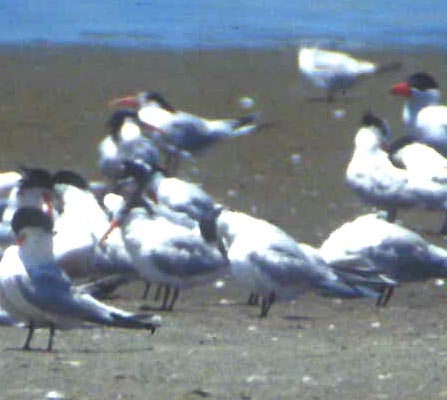 |
 |
 |
 |
The SANDWICH TERN is an exceptional vagrant to California but a very few have been located with Elegant Terns in coastal California. Elegant Tern has undergone a significant range expansion in recent decades, first in San Diego Co. and then north to Orange County. A Sandwich Tern appeared in the San Diego Bay colony in 1980, 1982, 1985, and 1987, and what may have been the same adult appeared in the Bolsa Chica colony in 1991 and each summer thereafter. This Bolsa Chica tern paired with an Elegant and likely laid eggs in 1993, 1994, and 1995. An apparent hybrid Sandwich X Elegant tern was at the Pajaro R. mouth, MTY/SCZ, in July 1995. That individual was in at least its second summer (per Claudia Wilds, in litt. to author, after I sent her a set of photos) and thus seems to have been the result of the Bolsa Chica hybrid pairing in 1993.
All of my California records are listed below. Those preceded by H were found or co-found by me personally; those preceded by K receive some partial credit (e.g., I was involved in sorting out i.d. of a previously discovered bird or refound a vagrant that had been thought to have left). These are my personal Sandwich Tern records:
5/26/82 south San Diego Bay SD adult in Elegant Tern colony; details in notes, transcribed belowI transcribe my notes on the 1982 bird below, written 26 May 1982:
7/5&7/95 Pajaro R. mouth MTY/SCZ hybrid SATE X ELTE; second-summer bird; details & sketch in notes, distant photos. The tern roost was on an island on the MTY side of the river, but the flock flushed and relanded several times, and occurred over SCZ airspace several times.
Sandwich Tern in Elegant Tern colony, salt works, south San Diego Bay. This bird had been reported by others in such widely separated spots as San Elijo Lagoon, San Diego R. mouth, and Tiajuana R. mouth within the last 1 1/2 weeks, but was not refound at any of these spots in subsequent days and I failed to find it at any of these spots (all checked) today. In late afternoon (about 5 pm) Elizabeth Copper, Richard Webster, and I checked this restricted area where a Sandwich Tern had occurred in May 1980.See the family page for county abbreviations. All photos & text © 2003 Don Roberson; all rights reserved.
The Elegant Tern colony of (by my estimate) 600-700 birds was located on the far (north?) side of the salt works, thus adjacent to the bay itself. The colony was densely packed in 5 main groups below or alongside the loosely-packed Caspian Tern colony. The Elegant Tern colony contained newly-hatched chicks. After a half hour search, Richard spotted the bird with his 25-60X scope and we noted (at perhaps a quarter mile) the similarly-shaped (in general) but decidedly smaller white tern with 1) a black cap with shaggy crest, 2) pearly gray mantle, 3) short black legs, and, most importantly, the 4) comparatively long, slim black bill with a decidedly cut-off clear yellow tip. The long slim bill (for its size) and short shaggy crest give the bird a distinct head shape as well as color
Although we had no effect on the birds in the Elegant Tern colony, the Sandwich Tern was very flitty -- either constantly being harassed by Elegants or tilting its head up and snapping at landing birds. Within minutes, it would get up and fly to another pod of Elegants,. Sometimes we picked it up in flight with binoculars by the small size and very white flight appearance, but the only really useful views were obtained at 40-45X with the scope, which was shared by the three of us. Even when we knew where it was, it could disappear from view among the densely-packed Elegants.
Elizabeth went to call other birders and the bird promptly got up and flew off. Within an hour, Elizabeth had returned with Guy McCaskie, Dennis Parker, Jerry Oldnettle, Dave Povey, and Bart Cord. It took another 20-40 minutes of search before the bird was refound in the original clump of terns and all got to see it.
Since there were unconfirmed reports of the bird in May 1981, we speculate this bird could be the same tern returning for its 3rd spring. If so, it remains responsible for the first and only state record to date.